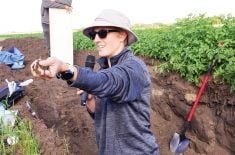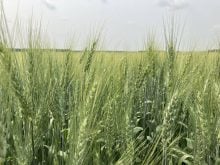Online applications that calculate the amount of nutrients removed by a crop have been around for a while.
But the new tool developed by researchers at the University of Saskatchewan will be more accurate because it’s based on new agronomic data from the Prairie provinces.
The Prairie Nutrient Removal Calculator is built upon data collected in Western Canada from 2020-22.
“The reason we started the whole study was the Canadian Fertilizer Institute had a really good handout that was on every agronomist wall for many years, but that was revised in 2001,” said Fran Walley, soil scientist from the University of Saskatchewan.
Read Also

Agritechnica Day 2: The future of tractor power, building quicker crop apps and large farms and tech
Agritechnica Day 2: The future of tractor power, building quicker crop apps with Syngenta and large farms and tech
“It turned out that data (tracked) back to 1992. It was a revision of a 1992 document, so we’re guessing the actual data was probably collected during the ’80s.”
She said a lot has changed in Canadian agriculture in the past 40 years, including new varieties, different management systems and the incorporation of pulse crops on many farms.
Rich Farrell also worked on the three-year project, which was done in collaboration with Nutrien Ag solutions and the agriculture departments in Manitoba and Saskatchewan.
“We had conversations with them and they worked with local agronomists to go out and contact their farmers that they normally work with, to see if they would allow us access to their fields,” Farrell said.
“We wanted some biomass samples for nutrient uptake and we wanted the harvest samples. If we were getting biomass samples and harvest samples, we wanted them from the same fields so everything was consistent. Logistically, it was a really big thing to pull together.”
He said the co-ordination with the agronomists by the ministries in the two provinces and Nutrient Ag Solutions made it possible to collect 2,200 samples of 15 crop types from more than 300 farms across the three Prairie provinces.
“The agronomists would go out to the farm fields, they would collect samples, they’d send them back to their co-ordinator who would send them to us.”
He said plant tissue was collected during a growth stage when it was expected the plant was using the greatest amount of soil nutrients. This was used to measure the amount of nutrients the crop takes up.
Grain samples and yield data were collected during harvest from the same location the tissue samples were collected, to measure the nutrient removal rate.
Farrell said the nutrient removal rates will be the most valuable metric for producers.
Walley said the Prairie Nutrient Removal Calculator also includes the micronutrients copper, boron and zinc.
The online calculator is available at prairienutrientcalculator.info.
















